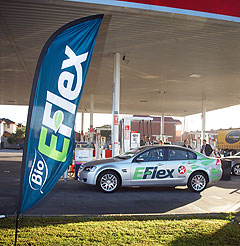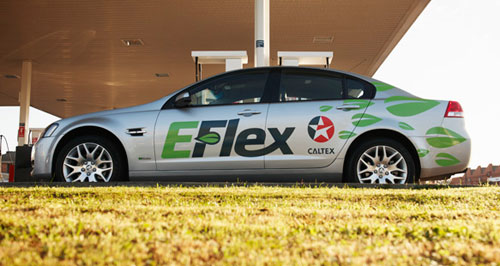Make / Model Search
News - General NewsGreen credit tipped for biofuelsEco benefit: Holden is set to offer an E85-capable Commodore within weeks. ‘Discount’ on ethanol CO2 emissions likely to reward car-makers under new rules17 Aug 2010 CAR-MAKERS who sell vehicles capable of running on biofuels such as E85 ethanol are likely to get a ‘discount’ from mandatory fuel efficiency standards proposed for Australia from 2015. The motor industry says each biofuel-capable car should earn the manufacturer a credit towards the car-maker’s fleet average fuel consumption figure in recognition of the renewable source of such fuels. Although the volume of carbon dioxide emitted from the E85 car’s tailpipe is little different to those of cars running on fossil fuels such as petrol or gas, proponents of ethanol argue that up to 50 per cent of C02 is either recaptured in the growing of plants such as sugar cane or sorghum used to brew the fuel or, in the case of ethanol made from waste, uses carbon that would otherwise be emitted from landfill as methane – another greenhouse gas. Holden, which is set to introduce an E85-capable Commodore within months, would be one of the big winners from such a scheme. The credits would make it a little easier for the Australian car-maker to achieve the proposed mandatory average C02 emissions ceiling across its fleet of new vehicles offered in Australia. Prime Minister Julia Gillard has committed a Labor government to introducing compulsory CO2 emissions regulations by 2015, floating a figure of 190g/km – a cut of more than 30g/km over the current Australian average of 222g/km.  A coalition government is likely to adopt a similar proposal, given the plan already has qualified support from the Australian car industry which has floated its own figure of 195g/km ahead of post-election bargaining. A coalition government is likely to adopt a similar proposal, given the plan already has qualified support from the Australian car industry which has floated its own figure of 195g/km ahead of post-election bargaining.On biofuels, Australia is likely to fall into line with Europe which is rolling out legislation that offers a five per cent ‘discount’ on official CO2 emission figures for vehicles that run on E85 – a blend of between 70 and 85 per cent ethanol and the remainder petrol. This means an E85-capable car that emits 200 grams of CO2 per kilometre under the standard official test is discounted by five per cent to 190g/km. The United States’ Environment Protection Agency (EPA) also has a system of ‘flex fuel credits’ under that country’s Corporate Average Fuel Economy (CAFE) rules. These credits are being revised under President Barack Obama’s national fuel policy, but the new credits will be locked from 2012 until 2015, after which they will be reviewed. Federal Chamber of Automotive Industries chief executive Andrew McKellar told GoAuto that he believed a credit for biofuels such as E85 should be built into the proposed C02 regulations as an incentive to car-makers to offer alternative fuels and as a recognition of the environmental benefits of those vehicles. “That (system) should be recognised in the accounting methodology, in terms of achievement of individual corporate targets, and it should be built into the accounting methodology of the industry achievement of an overall target,” he said. “In Europe, they have specific emissions targets for alternative fuels vehicles.” Mr McKellar said the European Union legislation – passed in April 2009 and now being legislated by individual parliaments across Europe – stated that: “For the purpose of determining compliance by a manufacturer with its specific emissions target, the specific emissions of each vehicle designed to be capable of running on E85 85 per cent ethanol shall be reduced by five per cent.” Mr McKellar said that in the US, ‘flex fuel super credits’ had been a long-standard feature of the CAFE system of fuel mileage regulations. “I would envisage that if we are introducing a new mandatory standard here, those sorts of incentives will need to be built into any mechanism that will be contemplated in Australia,” he said. “My expectation is that regardless of the outcome of the election, the industry has acknowledged that it sees the introduction of that sort of approach to a new consistent standard as the pathway way to go forward.” Biofuels took a major step forward earlier this month when Caltex Australia opened the first of 100 E85 outlets across Australia The initial 31 outlets are set to be open by October when Holden’s new EcoFlex Commodore hits the market in 3.0-litre V6 and 6.0-litre V8 forms. Ultimately, Holden will also switch its mainstream 3.6-litre V6 Commodore to E85 capability as well, and has plans to extend the technology to Cruze and other models. According to the federal government’s Green Vehicle Guide, Holden’s current models have C02 figures ranging from a low of 166g/km for its 1.8-litre Cruze small car to 328g/km for its 3.6-litre petrol Colorado ute. Under the proposed rules governing fuel efficiency, the average C02 figure of all the cars of various models sold by a company will be calculated, and that figure will be required to fit under the mandatory ceiling or the company will face penalties. To achieve the expected target of 190g/km, motor companies are taking a multitude of routes, such as petrol-electric hybrid technology of Toyota Camry Hybrid, range-extender hybrids such as Holden’s forthcoming Volt, and new, more efficient engines such as Ford’s EcoBoost 2.0-litre four-cylinder Falcon and diesel Territory. The E85 ethanol route is one of the simplest, requiring only a few mechanical and electronics tweaks to the vehicle to cope with the alternative fuel that, compared with pure petrol, has lower lubrication properties, a greater corrosiveness and can vary in its octane rating according to the ratio of ethanol to petrol in the tank. The current petrol-powered 3.0-litre SIDI Commodore emits 221g/km in official tests. Assuming that the new EcoFlex E85-capable version of the came car emits the same levels of CO2 under the official government test, a five per cent credit for E85 capability would bring its official rating down to 210g/km – closer to the proposed 190g/km average. As such engines run happily on ordinary unleaded fuel, there is no requirement for owners to fill them with E85, although a lower price of about $1 a litre is expected to tempt them to do so. The White House decided to review the flex fuel credit in the US in 2015 because of a tendency in of owner of E85-capable cars in that country to simply run their vehicle on petrol, to no environmental advantage, mainly because of the lack of E85 outlets. Continuation of the flex-fuel credits beyond 2015 under the new fuel plan in the US will depend on the ability of car companies to demonstrate that drivers of such vehicles are indeed filling up with E85. The US Environment Protection Agency has been charged with working out a method of doing that.  Read more |
Click to shareGeneral News articlesResearch General News Motor industry news |












Facebook Twitter Instagram